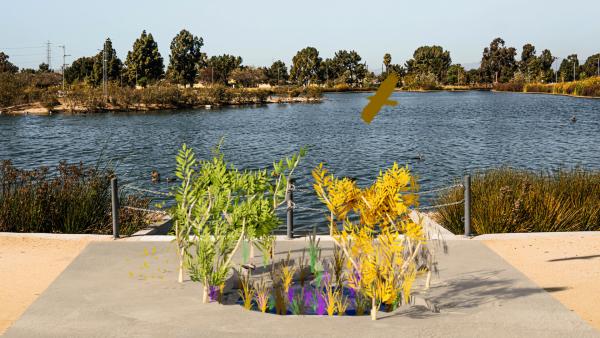LACMA × Snapchat: Monumental Perspectives is a multi-year initiative that brings together celebrated artists and leading technologists to create augmented reality monuments exploring histories of Los Angeles communities. In consultation with community leaders and historians, the initiative’s third and final collection of artists, Victoria Fu, Yassi Mazandi, Rashaad Newsome, Rubén Ortiz Torres, and Alison Saar, have used the lens of collective ancestral memory to examine the individual and communal legacies we leave today and have created works designed to be experienced at locations across Los Angeles with Snapchat’s camera.
We're also revisiting work by previous Monumental Perspectives collections. Below, learn more about Sandra de la Loza monument What the Willow Whispers from Collection II.
Sandra de la Loza is a third-generation Angeleno with roots in historic Los Angeles working-class barrios. De la Loza conducts deep research on the stories of this land and its people through nature and city walks, visits to archives, oral histories, and participation in local community struggles. Through immersive installations, video, photography, and public art, her work investigates the layers that comprise our present environmental and social landscapes as a means to decolonize, heal from historic and systemic violence, and create circles that empower liberated social relationships.
For the second iteration of the LACMA × Snapchat: Monumental Perspectives, De la Loza imagined a live and dynamic monument like the creek that once flowed near Earvin “Magic” Johnson Park. Her lens revives the native plants that construction and oil storage facilities once diminished. Trees, birds, and animals resurface from a primordial pool that bursts through concrete. Music by local artist Carlos Gabriel Niño and Friends add the sound of wind, water, and seed pods rattling into the environment. The ecosystem in the lens grows and transforms by season, illustrating how the land is interconnected with time and history. What the Willow Whispers recalls the past to urge a healthy, thriving vision of new ecologies in the future.
What the Willow Whispers was developed as a virtual living monument in the form of a native micro-ecology and garden that roots itself deep into the dormant but awakening social and ecological underlayers of today’s Earvin “Magic” Johnson Park park and the neighboring community of Willowbrook. With material drawn from archival and community-engaged research, this project looks at the shifting environmental and cultural contours of the park and of Willowbrook, a neighborhood named after the willows that grew near the springs that were likely connected to Compton Creek, the last major tributary of the L.A. River before it spills into the Pacific Ocean.
Understanding the land and its storied history as a continual unfolding that rises and falls, appears and disappears, the willows, forgotten springs, and past communities surface above and below ground. A soundscape composed of the gurgles of the spring and the willows own whispered stories and songs of the place float through space. The “garden” that sprouts from this living dynamic underground morphs the human into the ecological, sprouting the varied social, cultural, and agricultural stories that surface within the research process of this project that have unfolded in this rich, storied place through urban development. What the Willow Whispers pays homage to the dynamic biological, spatial, and temporal processes through which material of our past feeds and generates shifting and morphing social, biological, and cultural practices and processes into continually unfolding futuristic environments and worlds that are simultaneously familiar, mysterious, and uncanny.
This artwork imagines monuments that are fluid, alive, and dynamic like the streams that once flowed on the proposed site. It gives presence to a largely Black and Chicane/Latine community’s history and memory through strategies that allow for shifting, layered, living, and complex storytelling. Through morphing, recombining, and shapeshifting, this work draws from official and unofficial records of communities that have been historically under- and misrepresented within the larger dominant culture. The project hopes to inspire a deepened relationship to place and future community, cultural, educational programs that can draw from intertwined social and ecological histories.



